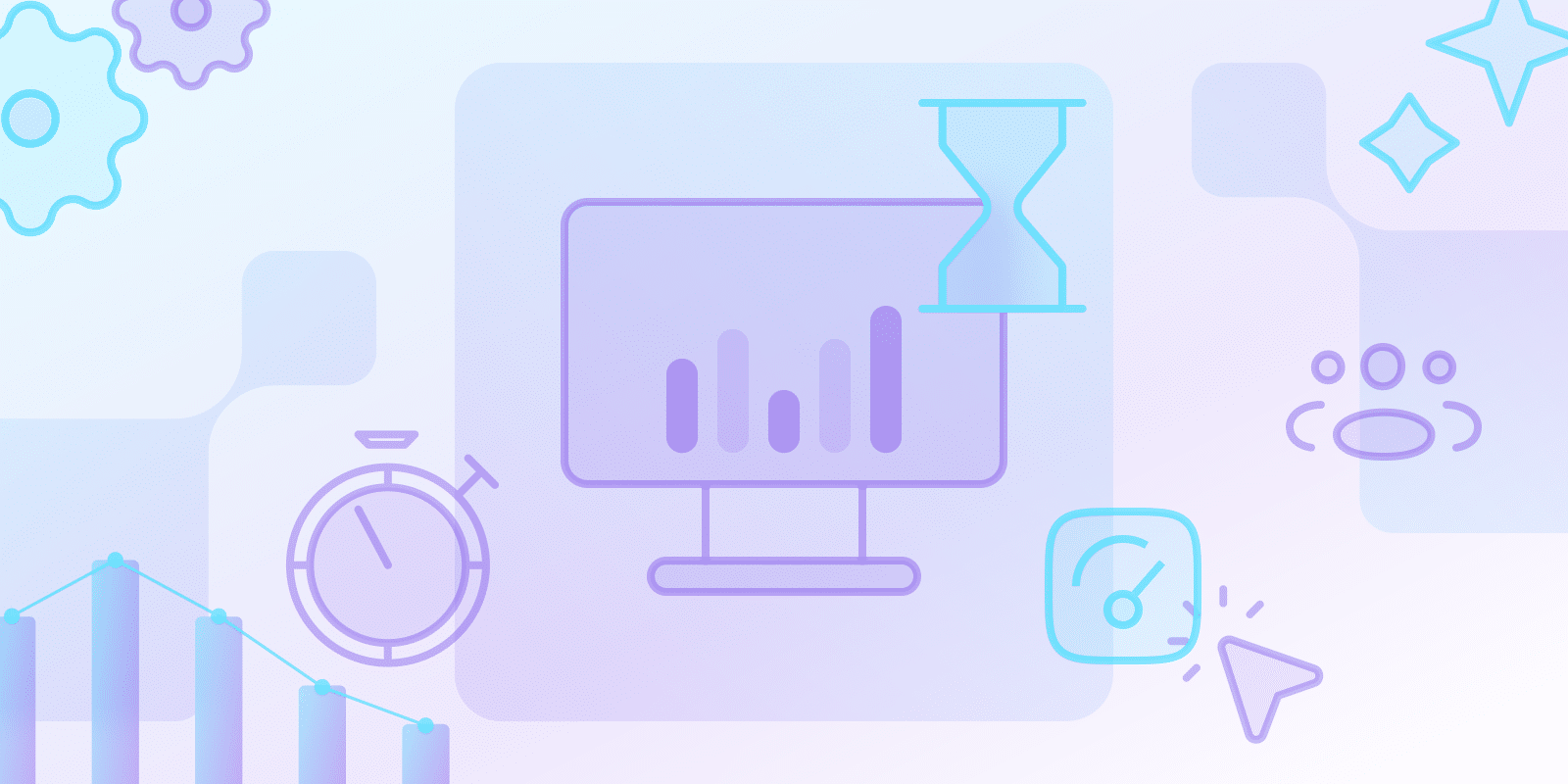SaaSの指標とKPI
SaaSセッション時間とは?

SaaSセッション時間とは?
ユーザーがSaaS製品を1セッションでアクティブに使用している時間は、SaaSセッション時間と呼ばれます。この指標は、ユーザーエクスペリエンス、コンテンツの有効性、およびユーザーエンゲージメントを適切に表すものです。セッション時間が長いということは、ユーザーが製品に積極的に関わっており、目標達成に向けて進捗していることを示している可能性があります。
セッション時間は有用なエンゲージメント指標ですが、その根底にある理由を探ることで、アプリケーションのエクスペリエンスとそのユーザーによる採用において、それが肯定的な側面なのか否定的な側面なのかをより明確に理解することができます。SaaSセッションの長さは、ユーザーが非常に興味深いと感じる特定の機能やコンテンツに関する詳細を明らかにする可能性もあります。
企業は、セッションデータを調べることで、自社製品のどの側面がユーザーにとって魅力的かを判断し、提供内容を調整できます。SaaSセッション継続時間の許容範囲は、製品の特性や顧客が実行する一般的なタスクによって大きく異なる可能性があることを覚えておくことが重要です。たとえば、生産性向上ツールは、ソーシャルメディアサイトよりも長いセッションを想定している場合があります。
ユーザーエンゲージメントを測定するための指標として、SaaSセッション時間はどれほど効果的ですか?
SaaSセッションの長さは、ユーザーが製品と積極的にやり取りしている時間を示すため、ユーザーエンゲージメントを評価するための有用な指標となります。セッションが長いほど、一般的に、ターゲットオーディエンスにアピールする機能、魅力的なコンテンツ、使いやすいインターフェースと関連付けられます。セッション継続時間の統計を分析することで、ユーザーが最もエンゲージしている場所と、摩擦や無関心を抱いている可能性のある場所を特定できます。このデータは、製品、オンボーディング手順、および全体的なユーザーエクスペリエンスを改善するための実用的な洞察を提供します。
- 特定のインタラクションの包括的な概要を示します。セッション時間をユーザー層、機能の使用状況、その他の要素に基づいてセグメントに分割し、さまざまなユーザーグループが製品とどのようにインタラクトしているかを確認できます。
- さまざまなエンゲージメント指標の増加に関連しています。ユーザーエンゲージメントの全体像を把握するには、セッション時間、ページビュー数、直帰率、その他の指標を併せて確認する必要があります。
- 存在する可能性のあるバイアスの程度を判断するには、データの徹底的な評価が必要です。セッション中の非アクティブ状態は、必ずしも非エンゲージメントと同じではありません。ユーザーが他のプロジェクトで作業中にセッションを開いたままにすると、セッション時間が水増しされる場合があります。
- 質的な関与についてはほとんど知られていません。セッションの長さは参加レベルを示すものではありません。ユーザーがページで多くの時間を費やすのは、楽しんでいるからではなく、混乱しているからかもしれません。
平均セッション時間データを分析することで、SaaS企業はどのようにセールスファネルとコンバージョン率を向上させることができますか?
SaaS企業は、平均セッション時間に関するデータを分析することにより、セールスファネル全体にわたるユーザー行動について多くのことを学び、改善すべき領域を特定できます。企業は、コンバージョンを阻害する可能性のあるボトルネックを特定し、エンゲージメントを高めるためのコンテンツを強化し、ユーザーが特定のページまたはセールスプロセスの段階に滞在する時間を追跡することで、リードの絞り込み基準を改善できます。
この情報は、製品デモ、ランディングページ、サインアッププロセスが潜在的な購入者とどのように相互作用するかを示すため、コンバージョン率の最適化にとって特に重要です。企業は、さまざまなオーディエンスセグメントに合わせてメッセージングとコンテンツをカスタマイズするために、セッション長の傾向を理解することがいかに重要かを強調しています。短いセッションは必ずしも無関心を示すわけではないため、セッション時間データを慎重に解釈することが重要です。
コンテンツとユーザーエクスペリエンス(UX)の変更は、SaaSのセッション時間にどのように影響しますか?
コンテンツと ユーザーエクスペリエンス(UX) SaaSセッションの持続時間に大きな影響を与える可能性があり、ユーザーの満足度とエンゲージメントに影響します。パフォーマンスの向上、オンボーディングの効率化、UIの改善は、セッション時間を延長し、消費者がSaaS製品をさらに深く掘り下げるよう促すために不可欠です。これらの調整は、ユーザーエンゲージメントを高めることで、コンバージョン率の向上と製品利用の促進につながる可能性があります。コンテンツとユーザーエクスペリエンスの変更による効果は、ターゲット市場の特定の要件と期待によって異なることを覚えておくことが重要です。
平均セッション時間は、SaaS製品に対する顧客の関心、関与、および満足度をどのように反映していますか?
SaaS分野において、平均セッション時間は、消費者の関心、エンゲージメント、および満足度を示す有用な指標です。セッションの長さから、顧客の商品に対する関心の度合いを推測できます。セッション時間が長い場合は、長期にわたるエンゲージメントと探求を示唆しており、ユーザーが機能や利点に関心を持っていることを示している可能性があります。セッションの長さは、長かろうと短かろうと、必ずしもエンゲージメントレベルを示すものではありません。製品の操作中や複雑な点を理解しようとしているときに発生した技術的な問題は、セッションの妨げになる可能性があります。
顧客が製品をどれくらいの時間使用しているかを追跡することで、製品が顧客の要求をどれだけ満たしているかについて多くのことを学ぶことができます。典型的なセッション時間は、製品の種類、業界、およびユーザーの目標によって大きく異なる可能性があることを覚えておくことが重要です。したがって、この指標を適切に評価するための鍵は、明確な製品目標を設定し、業界標準と比較することです。
SaaS企業が製品を最適化し、セッション時間を延ばすためのベストプラクティスは何ですか?
SaaSセッション時間を延長するためのベストプラクティスを以下に示します。
- ユーザーエクスペリエンスをカスタマイズする
- 信頼性が高く、迅速なパフォーマンスを保証する。
- 主要なパフォーマンス指標(KPI)を監視する。
- データベースのパフォーマンスを最適化し、効果的な負荷分散を提供し、インフラストラクチャのセキュリティを確保する。
SaaS企業がユーザーエンゲージメントを包括的に分析するために考慮すべき追加の指標は何ですか?
セッション時間以外にも、SaaS企業は顧客満足度、維持率、機能エンゲージメントを分析して追加情報を取得できます。
- 機能エンゲージメントは、ユーザーが特定の製品機能とどのように対話するかを測定することにより、潜在的な摩擦点とユーザーの強い関心のある領域を特定します。
- その リテンション率 製品の長期的な価値提案を示し、ユーザーをどれだけ効果的に維持しているかについての洞察を提供します。
- 顧客満足度は、多くの場合、アンケートやネットプロモータースコア(NPS)によって測定され、ユーザーの満足または不満の特性を浮き彫りにし、製品に対するユーザーの全体的な感情を表します。
SaaS企業は、これらの指標をセッション時間と併せて分析することで、ユーザーエンゲージメントの全体像を把握できます。これにより、 データに基づいた意思決定 マーケティング戦略について 製品開発.
結論
SaaSセッションの長さは、ユーザーエンゲージメント、製品満足度、および改善領域に関する貴重な洞察を提供する重要な指標です。SaaS企業は、セッション時間データを評価することにより、セールスファネルのコンバージョン率を向上させ、コンテンツとユーザーエクスペリエンスを最適化してエンゲージメントを高め、ユーザー行動に関する重要な洞察を得ることができます。セッション時間と、機能エンゲージメントや顧客満足度などの他のユーザーエンゲージメント指標を併せて追跡することで、ユーザー行動を徹底的に把握できます。これは、SaaS企業がデータに基づいた意思決定を行い、製品を効果的に改善するのに役立ちます。